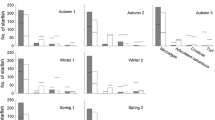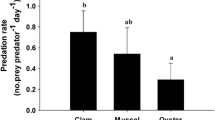Summary
The diet and foraging period of the neogastropod Acanthina punctulata were investigated in order to test various aspects of recent optimal foraging strategy models. This intertidal snail is an actively searching predator which preys on snails and barnacles by boring a hole in the shell and rasping out the flesh. Unlike many gastropod predators, Acanthina drill its gastropod prey at a very specific location on the columella, the thickest portion of the shell.
Acanthina's foraging period can be interpreted as a compromise between maximizing the energy obtained by feeding and minimizing risk of mortality from exposure to wave action. That foraging period minimizing risk of being dislodged by waves appears to be during low tide when the predators can be in shallow pools. However, prey cannot be captured and consumed during one low tide. Thus Acanthina must be exposed during some high tides, and its strategy appears to be to restrict movement while exposed. Thus search is not initiated during high tide, but drilling and prey consumption are continued during that time. A snail not drilling or consuming prey seeks the protection of crevices or large anemones during high tide. A model is presented to indicate the relative amounts of risk and net energy for Acanthina at successive low and high tides. Predictions from the model, e.g., minimizing search time to avoid being exposed for an additional high tide and no movement during high tide are supported by field data. Acanthina commences foraging at the beginning of low tide, searches initially for preferred prey, but if unsuccessful, settles for a less preferred prey and begins drilling this prey before the end of low tide. Drilling and ingestion of prey occur during the following high and sometimes low tides. These “handling times” take 95% of the total foraging time in the field, while search time takes only 5% (pursuit time is negligible). Drilling alone accounts for 48–70% of the total drilling and eating time. In the laboratory, drilling and eating time for littorine food ranged from 15–60 hrs per item. The time to drill and eat a littorine increases exponentially with prey length. Since handling and processing prey items represents such a large investment of time, Acanthina would be expected to be very selective with respect to choice of prey items. Electivity coefficients from field data suggest that littorines are preferred over barnacles. Acanthina in the laboratory optimizes the amount of biomass ingested per time by choosing larger littorines over smaller ones and by preferring the more readily drilled species.
It is suggested that Acanthina obtains information about the range of prey available initially by encountering and evaluating quite a few prey before making a selection, but usually by comparing an item of prey encountered to the prey it recently ingested. This latter method should provide a basis for evaluating prey encountered and has the advantage of reducing search time, the total amount of time spent feeding and thus the high-tide time exposed to wave action.
In a similar manner, the decrease in the level of acceptability of prey as search time increases represents a compromise between maximizing energy obtained and minimizing risk from mortality.
Similar content being viewed by others
References
Bigler, E.: Attrition on the Littorina planaxis population. Pacific Grove, Calif.: Hopkins Marine Station, Student report 1964
Bock, C. E., Johnson, R. E.: The role of behavior in determining the intertidal zonation of Littorina planaxis Philippi, 1847, and Littorina scutulata Gould, 1849. Veliger 10, 42–54 (1967)
Coast and Geodetic Survey: Tide Tables, West Coast of North and South America. U.S. Department of Commerce (1970, 1971)
Dayton, P. K.: Two cases of resource partitioning in an intertidal community: making the right prediction for the wrong reason. Amer. Naturalist 107, 662–670 (1973)
Dixon, A. F. G.: An experimental study of the searching behavior of the predatory coccinellid beetle Adalia decempunctata (L.). J. An. Ecol. 28, 259–281 (1959)
Emlen, J. M.: The role of time and energy in food preference. Amer. Naturalist 100, 611–617 (1966)
Emlen, J. M.: Optimal choice in animals. Amer. Naturalist 102, 385–388 (1968)
Frank, P.: The biodemography of an intertidal snail population. Ecology 46, 831–844 (1968)
Holling, C. S.: The functional responses of invertebrate predators to prey density. Mem. Entomol. Soc. Can. 48, 1–86 (1966)
Ivlev, V. S.: Experimental ecology of the feeding of fishes, 302 p. New Haven: Yale Univ. Press 1961
Kruuk, H.: The spotted hyena. Chicago: University of Chicago Press 1972
MacArthur, R. H., Pianka, E. R.: On optimal use of a patchy environment. Amer. Naturalist 100, 603–609 (1966)
MacGinitie, G. E., MacGinitie, N.: Natural history of marine animals, 2nd edition. New York: McGraw Hill 1968
McLean, J. H.: Marine shells of Southern California. Los Angeles County Museum of Natural History, Science Series 24, Zoology No. 11 (1969)
Menge, B. A.: Foraging strategy of a starfish in relation to actual prey availability and environmental predictability. Ecol. Monogr. 42, 25–50 (1972)
Menge, J. L., Menge, B. A.: Resource allocation, aggression and spatial heterogeneity in coexistence of two competing intertidal starfish. Ecol. Monogr. 44, 189–209 (1974)
Murdoch, W. W.: Switching in general predators: experiments on predator specificity and stability of prey populations. Ecol. Monogr. 39, 335–354 (1969)
Paine, R. T.: Function of labial spines, composition of diet, and size of certain marine gastropods. Veliger 9, 17–24 (1966)
Pulliam, H. R.: On the theory of optimal diets. Amer. Naturalist 108, 59–74 (1974)
Rapport, D. J.: An optimization model of food selection. Amer. Naturalist 105, 575–587 (1971)
Royama, T.: Factors governing feeding rate, food requirement and brood size of nestling great tits Parus major. Ibis 108, 313–347 (1966)
Salt, G. W.: Predation in an experimental protozoan population (Woodruffia-Paramecium). Ecol. Monogr. 37, 113–144 (1967)
Schaller, G.: The Serengeti Lion, 480 p. Chicago: University of Chicago Press 1972
Schoener, T. W.: Optimal size and specialization in constant and fluctuating environments: an energy-time approach. Brookhaven Symp. Biol. 22, 103–144 (1969)
Schoener, T. W.: Theory of feeding strategies. Ann. Rev. Ecol. and Syst. 2, 369–404 (1971)
Schoener, T. W.: Temporal resource partitioning and the compression hypothesis. Proc. nat. Acad. Sci. (Wash.) (in press, 1974)
Tittle, K. M.: Chemically stimulated excape response of Littorina planaxis and Littorina scutulata to the carnivorous gastropod, Acanthina spirata. Pacific Grove, Calif.: Hopkins Marine Station, Student report 1964
Wolf, L. L., Hainsworth, F. R., Stiles, F. G.: Time and energy budgets of territorial hummingbirds. Ecology 52, 980–988 (1971)
Wolf, L. L., Hainsworth, F. R., Stiles, F. G.: Energetics of foraging: rate and efficiency of nectar extraction of hummingbirds. Science 176, 1351–1352 (1972)
Author information
Authors and Affiliations
Rights and permissions
About this article
Cite this article
Menge, J.L. Prey selection and foraging period of the predaceous rocky intertidal snail, Acanthina punctulata . Oecologia 17, 293–316 (1974). https://doi.org/10.1007/BF00345748
Received:
Issue Date:
DOI: https://doi.org/10.1007/BF00345748




